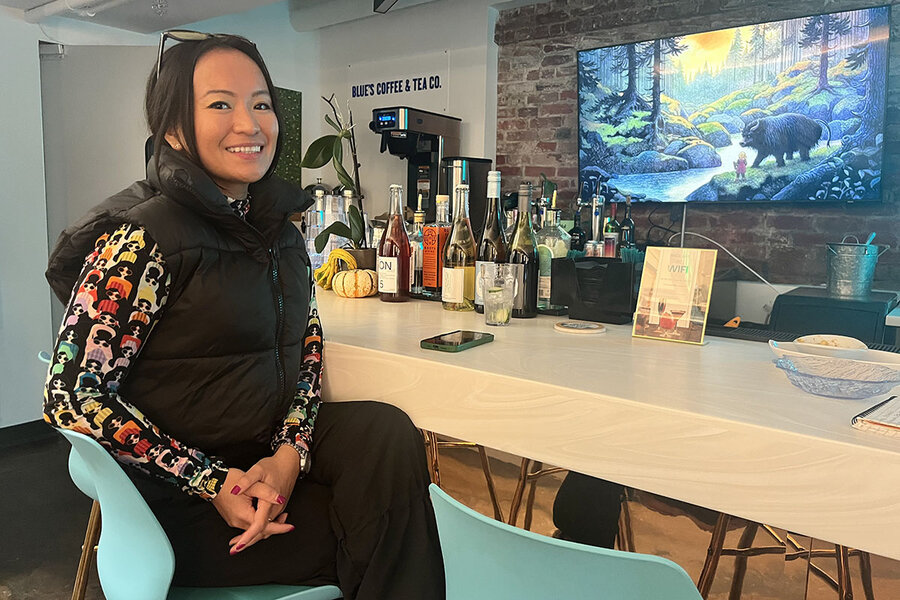Sober as a college student? Why Gen Z shrugs at alcohol.
Loading...
| Washington
Members of Generation Z are showing less interest in alcohol as a marker of adulthood than previous generations. It’s too soon to say whether this will mark a long-term shift akin to the decline in smoking cigarettes. But more 20-somethings are choosing to drink less frequently or abstain altogether. And millennials, now in their 30 and early 40s, are also dialing back alcohol consumption or nixing it entirely.
“It’s starting to become mainstream,” says John Wiseman, who founded a nonalcoholic beverage brand in 2015. “It’s right on the cusp, just the way that veganism and vegetarianism was like 10 years ago.”
Why We Wrote This
A story focused onIn a cultural shift, younger Americans no longer view alcohol as a status symbol of adulthood. Many are drinking less, or not at all.
This is not to say that Gen Z considers itself more ascetic than previous generations. The decline in drinking over the past decade has come as many states have legalized marijuana. And the biggest growth appears to be in young people who are drinking less, rather than totally abstaining.
Sipping on a glass of nonalcoholic pinot noir, Chasity Townsend says she first became sober to show solidarity with a cousin who was quitting drinking. It was hard at first, she says, but “I’ve never felt this healthy before.”
The menu at Binge Bar in Washington lists drinks like a Timeless Old Fashioned, Soul Spiced Apple Cider Mimosa, and Green Apple Mule. But there’s a twist: Everything is zero proof. It’s the area’s first (and only) alcohol-free bar, joining cities like Austin, Salt Lake City, San Francisco, and Omaha, Nebraska.
The average number of drinks consumed by Americans has been declining for more than a decade from 4.8 drinks per week in 2009 to 3.6 in 2021. The trend is being driven by younger adults, with the number of Gen Z and millennials who reported drinking less – or not at all – increasing over the past several years.
Members of Gen Z are showing less interest in alcohol as a symbolic marker of adulthood than previous generations. It’s too soon to say whether this will mark a long-term shift akin to the decline in smoking cigarettes, with only 5% of young adults now lighting up. But more 20-somethings are choosing to drink less frequently or abstain altogether. And millennials, now in their 30 and early 40s, are also dialing back alcohol consumption or nixing it entirely.
Why We Wrote This
A story focused onIn a cultural shift, younger Americans no longer view alcohol as a status symbol of adulthood. Many are drinking less, or not at all.
“It’s starting to become mainstream,” says John Wiseman, who founded a nonalcoholic beverage brand in 2015. “It’s right on the cusp, just the way that veganism and vegetarianism was like 10 years ago. That’s where sober curiosity is now.”
This is not to say that Gen Z considers itself more ascetic than previous generations. The decline in drinking over the past decade has come as many states have legalized marijuana. And the biggest growth appears to be in young people who are drinking less, rather than totally abstaining. But colleges are reporting growing interest in substance-free housing. And the trend appears to have begun prepandemic, with 28% of college students in 2018 saying they eschewed alcohol entirely, up from 20% in 2002, according to a 2020 study by the University of Michigan.
“It’s been in the zeitgeist for a few years now. And people are realizing that it’s just as cool to choose whatever you want to do with your body when it comes to your diet and your health,” Mr. Wiseman says. More people are cutting back “now that the stigma around not drinking is not exclusively around sobriety, but more just out of sober curiosity.”
A higher number of Americans than ever now say that consuming one to two drinks a day is unhealthy, up 11% from 2018. That increase is highest among adults 18-34, 18% more of whom now say alcohol consumption is detrimental than in 2018. Among Americans aged 35-54 there’s a 13% increase. Among those 55 and older, there’s virtually no change.
Mentions of nonalcoholic beverages on social media, including recipes, were up by over 10% from 2020 to 2021.
Current guidance from the Centers for Disease Control and Prevention recommends no more than two drinks a day for men and one for women, and the World Health Organization maintains that no level of alcohol consumption is healthy. The Canadian Centre on Substance Use and Addiction also released guidance stating that no level of alcohol consumption is safe and recommended a maximum of two drinks per week.
Having mocktails on a menu is a good selling point to customers, whether they’ve been sober for one day or for years, says William Jovel, the head bartender at Residents Cafe & Bar in Washington. “We approach all our drinks with the same mentality,” says Mr. Jovel, in terms of sophistication – which is why people are willing to pay the same for a mocktail that they would for a cocktail.
Mr. Jovel has been sober for six years, during which time he’s seen a definite expansion of nonalcoholic spirit brands like Seedlip and Lyre, along with more options for nonalcoholic wines and beers.
There’s been “an uptick in nonalcoholic spirits,” especially post-pandemic, says Krystle Hewitt, food and beverage director at The Pembroke at The Dupont Circle hotel in Washington. “There’s a trend of people trying to be more cautious about what they’re intaking,” she says.
Some people came out of the pandemic feeling that they drank too much, says Ms. Hewitt. “People connect socializing with drinking, and because alcohol and socializing kind of go hand-in-hand, people who were choosing to live soberly for a very long time were ostracized for not drinking.”
The increase in nonalcoholic offerings “is allowing [sober] people to have all of the same things that drinkers have,” she says. “It’s nice to be able to offer maybe someone that’s Muslim or from another religion that can’t have alcohol a nonalcoholic option, so that culturally they don’t feel secluded based off of their religion.”
It’s the norm now for bars or restaurants to have two to three mocktails on their menu, says Ms. Hewitt. The popularity arc is similar to that of vegan food, she adds. “Ten years ago, no one thought about nonalcoholic beverages.”
A growing number of sober or “sober curious” celebrities are launching their own nonalcoholic beverage brands – from actor Danny Trejo and his nonalcoholic tequila, to singer Katy Perry’s nonalcoholic sparkling aperitifs, to football player J.J. Watt’s nonalcoholic beer.
While the culture is growing, it still isn’t the norm everywhere. Chasity Townsend, who moved to Washington from Arizona a few months ago, says it was tricky to find nonalcoholic options. And if a bar or restaurant did carry something, it was usually the same nonalcoholic beer every time. In D.C., most places offer options.
Sipping on a glass of nonalcoholic pinot noir at Binge Bar, Ms. Townsend says she first became sober to show solidarity with her cousin who was quitting drinking. It was hard at first, but she says, “I’ve never felt this healthy before and this in tune with my body.”
She remains sober mainly for her health. “It’s just something I wanted to do for myself,” she says.
“Honestly, beginning was really, really difficult because a lot of events and gatherings are so solely focused around alcohol. It’s really, really hard not to drink,” says Ms. Townsend. “Ultimately, it was a mental thing. It got easier.”
Gigi Arandid, the owner of Binge Bar, opened it in February to fill what she saw as a void for people battling addiction. “I wanted to open a space for people who wanted a safe space to manage their recovery,” she says.
Coming out of the pandemic “catapulted the industry forward,” she says.
Mr. Wiseman of Curious Elixirs saw the same effect. “Our growth started skyrocketing. I think a lot of people were drinking more. But then there were also a lot of people who were looking to make a change.”
The market isn’t just tens of thousands of people anymore, he says. Now it’s millions.
“The main group that has exploded in 2023, it’s the people who are just looking to drink less. It’s not the complete teetotalers,” he says. “That number is growing too, but the number that’s growing faster is the people who are cutting back.”
Curious Elixirs saw a surge in sales in 2021, followed by another in 2022. Mr. Wiseman calls 2023, “the inflection point, where instead of growing 30% to 50% ... [in] September, for example, we had 125% growth.”
Interest in nonalcoholic options “is cross-cultural,” Ms. Arandid says. Binge Bar has hosted events for a polyamory group, a solar company, and a Christian music group, in addition to pop up events with local retailers.
It also appeals to people who still drink alcohol occasionally – like one of Binge Bar’s bartenders. That’s why Ms. Arandid chose “venu ut es” as the bar’s tagline: It translates to “come as you are.”










